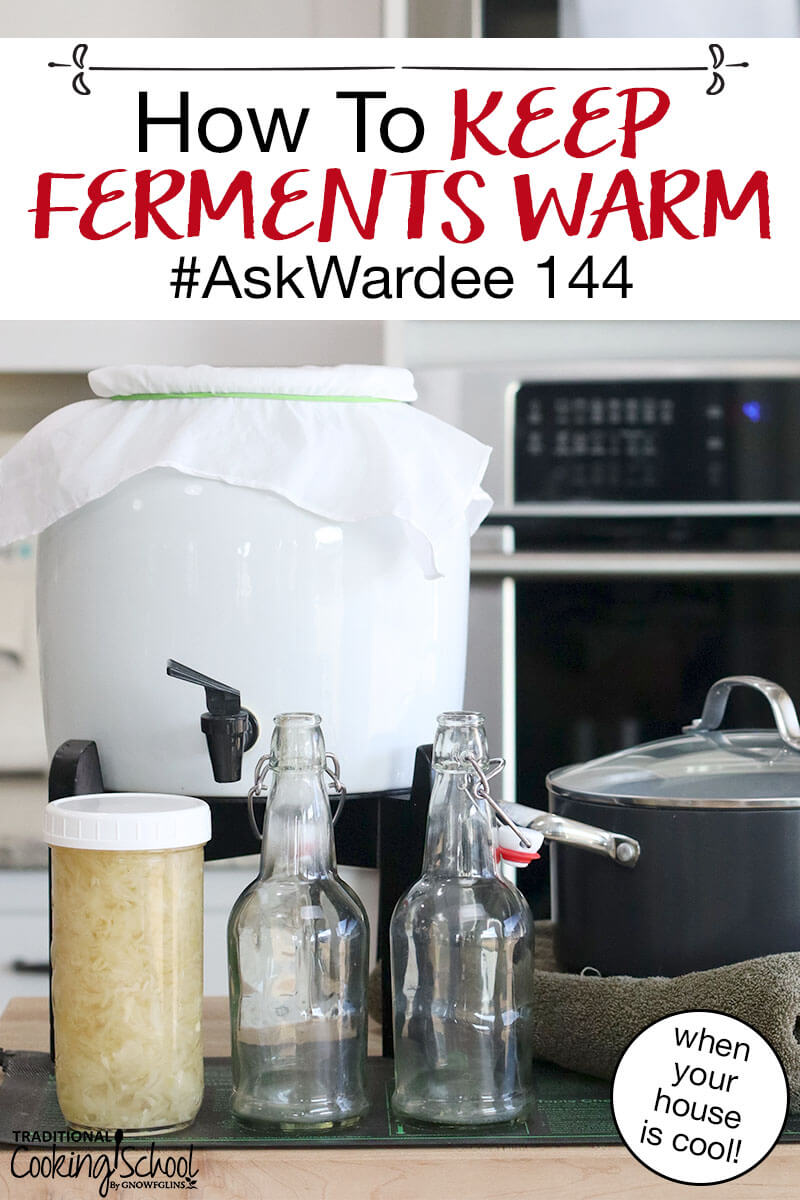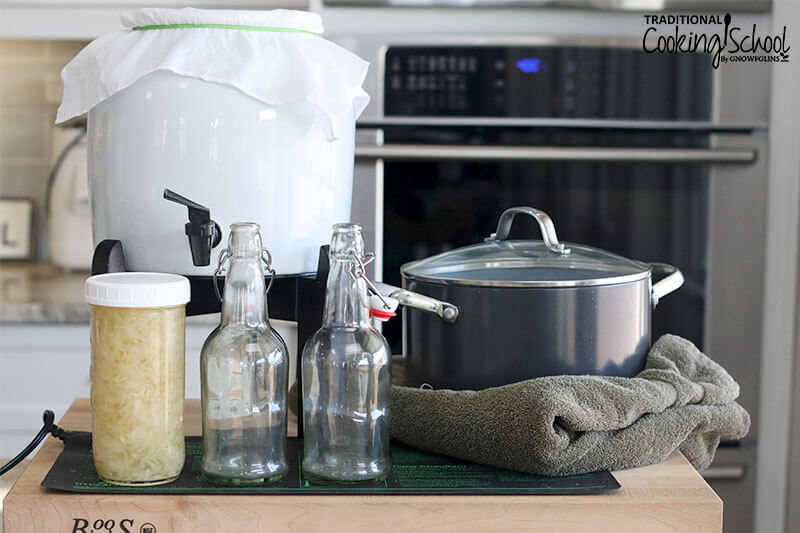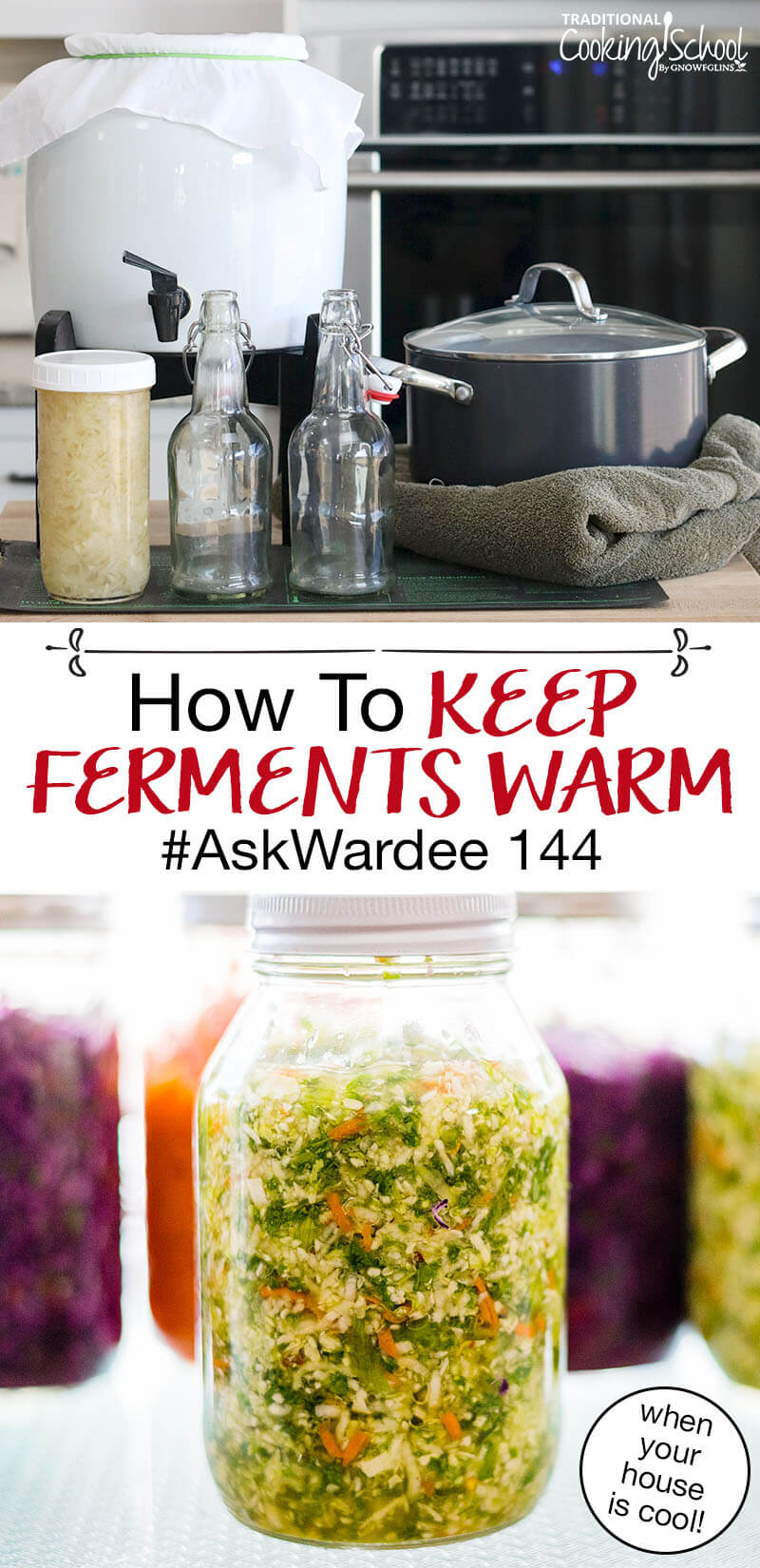Not sure how to keep your ferments happy during the fall or winter? Here are 4 simple ways to keep homemade ferments warm and thriving despite cool temperatures!

Homemade ferments need a warm room temperature to work properly.
Yet what if your house is cool? What if you just can’t keep your ferment warm enough?
How can you increase the temperature so you still end up with a good ferment?
I’m sharing tips for you on today’s #AskWardee! Keep reading or watching below to learn more!
Subscribe to #AskWardee on iTunes, Stitcher, YouTube, or the Podcasts app.
Table Of Contents
The Question: How Do I Keep My Ferments Warm When My House Is Cool?
Carina S. asked:
Can Wardee give some advice on caring for ferments if you live somewhere the temperature is cold, at least part of the year. I’m in Scotland, and my normal winter house temperature is between 54 – 65F, though I have an airing cupboard where it’s 65 – 80F, depending on location – it’s hotter at the top.
I know I can’t put all my ferments in this cupboard because of cross-contamination, but could I have some other ideas for keeping ferments cosy when it’s cold? I already use a heat pad for my kombucha, but would this heat from below work for other ferments? Or a narrow wrap-around heat belt I saw in a home brewing supplier? And what about putting ferments in a big box (insulated if possible) with a hot water bottle?
Carina, thank you for your question!
Because we’re featuring your question today’s #AskWardee, you’re getting a gift — a FREE eBook and Video Package! Our team will be in contact with you so you can choose which one you’d like!
What Is The Best Temperature For Fermenting?
The general range given for general lacto-fermenting is about room temperature, and room temperature is 72 degrees Fahrenheit.
However, most fruit and vegetable ferments like sauerkraut, chutney, Kombucha, and ginger beer, actually do better if the temperature’s a little warmer than that… as in mid 70s. So the range really is 70 to 80ish degrees Fahrenheit.
A sourdough starter also does best between about 70 and 85 degrees Fahrenheit.
One exception would be pickles, which you don’t want to ferment at over 80 degrees or else they’ll turn out mushy!
And of course, there are other exceptions, too, so if a recipe states a specific temperature, go by that. This is the case for yogurt and natto, for example.
Unfortunately, for a lot of us, our homes are 72 degrees Fahrenheit or below in the winter… which means our ferments might not work out at all or might take longer to ferment.
So what can you do about this? Here are ideas for you!

#1 — Use A Seedling Mat
Get a seedling mat, plug it in, and put your ferments like sauerkraut, Kombucha, water kefir, or honey-sweetened ginger beer on it so the jars or bottles will be gently heated from the bottom, ferment faster, and potentially turn out better.
With beverages, you can do the first and/or second ferment this way!
For larger fermenting vessels, like the Kombucha continuous brew ceramic container, you can wrap the seedling mat around it and secure it with a big band. It’s okay if the mat doesn’t wrap all the way; even a little will help.
#2 — Put Ferments In A Warmer Location In the House
Put your ferments on top of a refrigerator or freezer, next to the dryer, or anywhere that is warmer than other places.
I have a friend who would put a storage rack over a heating register and she would put her ferments on the rack. They would be gently warmed when the heat entered the house. It really worked!
#3 — Wrap Bath Towels Around Your Ferments
Bath towels (or blankets… like wool!) can really help to insulate ferments that are already warm.
If you’re culturing yogurt in a big pot, wrap that pot of warm milk with culture in multiple layers so it’s nice and insulated. Then put it in a location of your kitchen that’s away from drafts for the duration of the culturing time.
This is actually the way my grandmother and namesake, Tata Wardeh, taught my mom how to make yogurt the Arabic way!
#4 — Ferment In A Cooler With A Pot Of Hot Water Inside
In our Cultured Dairy & Basic Cheese eBook or eCourse, we give you a recipe for “Just Like The Store Yogurt” (shared by Katie at Kitchen Stewardship).
You put your pot (or jars) of warm milk with culture in a cooler lined with towels. You also put add a pot with hot water in the cooler.
Then close the lid. This hot water keeps the cooler warm to turn the milk into yogurt!
Change the water in the pot as needed. You can keep a thermometer inside to help you moderate the temperature.
Carina, you mentioned an insulated box… yes, that would work like a cooler in the method I described above!
Please note: I would avoid doing long-term ferments (as in multiple days) using this method, due to any potential for mold to grow in a moist, warm location.
More Fermenting Info, Reviews, and Recipes…
Check out my Lacto-Fermentation 101 Free Video Series RIGHT HERE.
And if you haven’t already, CLICK HERE to download our FREE “Fermenting Formulas” Cheat Sheet, where I share formulas so you can create your own safe ferments using the product you have on hand — salsas, relishes, krauts, beverages, and more!
We also have extensive archives of ferment recipes here!
Any Questions Or Comments?
If you have other questions or comments about your own experience with keeping ferments warm when your house is cool, be sure to leave them in the comments!
Helpful Links
- FREE “Fermenting Formulas” Cheat Sheet
- Cultured Dairy & Basic Cheese eBook or eCourse
- Seedling Mat
- Lacto-Fermentation eBook or eCourse
- How To Make Sauerkraut
- Honey Sweetened Ginger Beer
- How To Make Kombucha
- 5-Spice Apple Chutney
- Kombucha continuous brew system
What’s your favorite way to keep ferments warm when your house is cool? Share in the comments!
We only recommend products and services we wholeheartedly endorse. This post may contain special links through which we earn a small commission if you make a purchase (though your price is the same).



What about using the Instant Pot’s Yogurt setting (maybe at 0 minutes) just to get pressure up to warm the container?
That might work, Joan! You would not want to get your ferment TOO warm, but it might be worth a try! —Sonya, TCS Customer Success Team
Great ideas! I sometimes put ferments or things I needed to melt (like a big bottle of coconut oil) on top of my home water heater.